Java异常之try,catch,finally,throw,throws
你能区分异常和错误吗?
我们每天上班,正常情况下可能30分钟就能到达。但是由于车多,人多,道路拥挤,致使我们要花费更多地时间,这就是生活中的异常!
程序和生活一样都会出现异常,先来看个异常:

上面出现的是算数错误的异常。
在java中,除去一些编译上的错误(语法)之外,就有异常和错误!
异常的定义是可自己进行处理后,程序依然可以正常运行下去!错误是Java虚拟机抛出的,终止程序的运行,这就是程序和异常的区别。
一:什么是异常处理?
异常处理机制就像我们对平时可能遇到的意外情况,预先想好了一些处理的办法。也就是说,在程序执行代码的时候,万一发生了异常,程序会按照预定的处理办法对异常进行处理,异常处理完毕后,程序继续运行。
java的异常处理是通过5个关键字来实现的:try、catch、finally、throw、throws。
二:java异常类的层次结构
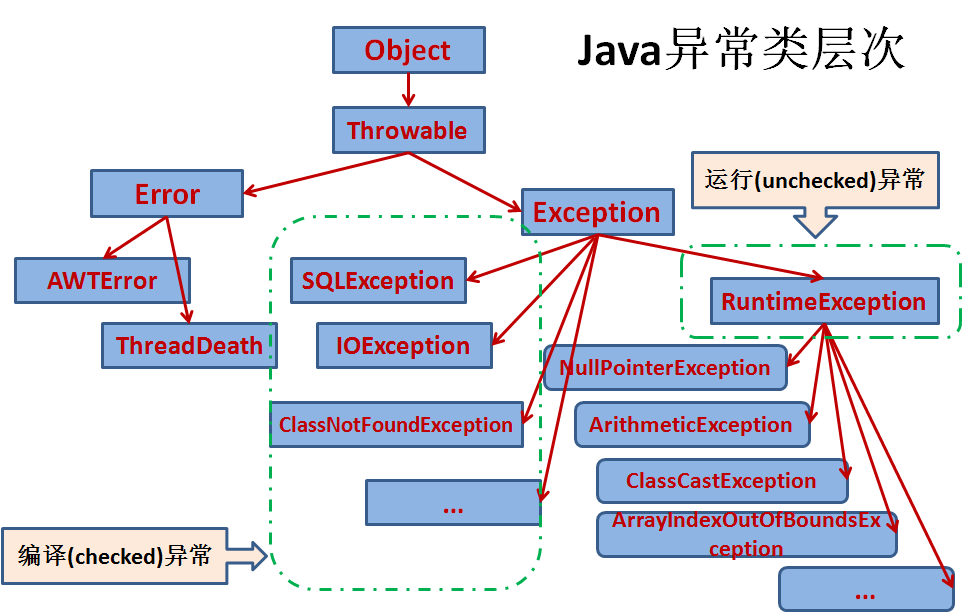
三.常见的异常类型
Exception 异常层次结构的根类
ArithmeticException 算数错误情形
ArrayIndexOutOfBoundsException 数组下标越界
NullPointerException 尝试访问null对象成员
ClassNotFoundException 不能加载所需的类
InputMismatchException 欲得到的数据类型与实际输入的类型不匹配
IllegalArgumentException 方法接受到非法参数
ClassCastException 对象强制类型转换出错
NumberFormatException 数字格式转换异常
四.具体实例
- try—catch
1 package Test; 2 3 import java.util.Scanner; 4 5 public class Test_Test { 6 public static void main(String[] args) { 7 Scanner input =new Scanner(System.in); 8 System.out.println("请输入被除数:"); 9 try { 10 int num1=input.nextInt(); 11 System.out.println("请输入除数:"); 12 int num2=input.nextInt(); 13 System.out.println(String.format("%d / %d = %d", 14 num1, num2, num1 / num2)); 15 }catch (Exception e) { 16 System.err.println("出现错误:被除数和除数必须是整数,"+ 17 "除数不能为零。"); 18 System.out.println(e.getMessage()); 19 } 20 }
运行结果如下:
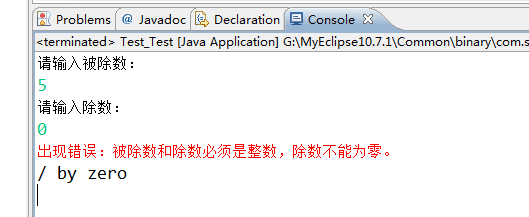
System.err.println();这种输出方式可以输出错误的消息,在控制台呈现红色。
System.out用于正常的输出,也就是程序真正想输出的内容。而System.err用于出错信息的输出,也就是你本来不期待看到的东西。
System.out.println(e.getMessage());
这行的作用是——返回该错误的详细信息的字符串。
- try-catch-finally
1 package Test; 2 3 import java.util.Scanner; 4 5 public class Test_Test { 6 public static void main(String[] args) { 7 Scanner input =new Scanner(System.in); 8 System.out.println("请输入被除数:"); 9 try { 10 int num1=input.nextInt(); 11 System.out.println("请输入除数:"); 12 int num2=input.nextInt(); 13 System.out.println(String.format("%d / %d = %d", 14 num1, num2, num1 / num2)); 15 }catch (Exception e) { 16 System.err.println("出现错误:被除数和除数必须是整数,"+ 17 "除数不能为零。"); 18 System.out.println(e.getMessage()); 19 } 20 finally{ 21 System.out.println("Thanks"); 22 } 23 } 24 }
运行结果如下:
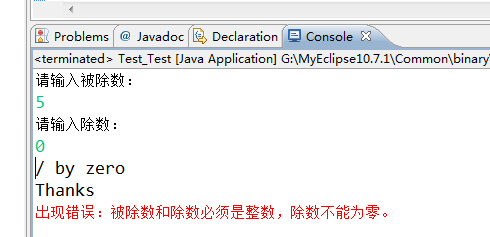
try-catch-finally 程序块的流程大致分为两种情况:
- 如果try块中所有语句正常执行完毕,那么finally块就会被执行。
- 如果try语句在执行过程中碰到异常,无论这种异常能否被catch块捕获到,都将执行finally块中的代码。
try-catch-finally结构中try块是必须有的,catch和finally块为可选,但两者至少必须出现其中之一。
- try—catch-catch-finally(多重catch块)
1 package Test; 2 3 import java.util.InputMismatchException; 4 import java.util.Scanner; 5 6 public class Test_Test { 7 public static void main(String[] args) { 8 Scanner input =new Scanner(System.in); 9 System.out.println("请输入被除数:"); 10 try { 11 int num1=input.nextInt(); 12 System.out.println("请输入除数:"); 13 int num2=input.nextInt(); 14 System.out.println(String.format("%d / %d = %d", 15 num1, num2, num1 / num2)); 16 }catch (InputMismatchException e) { 17 System.err.println("被除数和除数必须是整数。"); 18 } 19 catch (ArithmeticException e) { 20 System.err.println("除数不能为零。"); 21 } 22 catch (Exception e) { 23 System.err.println("其他未知异常。"); 24 System.out.println(e.getMessage()); 25 } 26 finally{ 27 System.out.println("Thanks"); 28 } 29 } 30 }
运行结果如下:
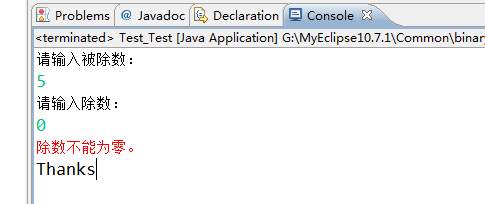
所以,在写异常处理的时候,一定要把异常范围小的放在前面,范围大的放在后面,Exception这个异常的根类一定要刚在最后一个catch里面,如果放在前面或者中间,任何异常都会和Exception匹配的,就会报已捕获到...异常的错误。
下面是try-catch-finally中包含return的情况:
- 情况一:try{} catch(){}finally{} return;
正常按程序顺序执行即可。
1 package Test; 2 3 public class Test_Test { 4 public static void main(String[] args) { 5 Test1(); 6 } 7 8 public static int Test1(){ 9 int x = 1; 10 try 11 { 12 x++; 13 System.out.println("我有用!"); 14 } 15 catch (Exception e) { 16 System.out.println("我没用!"); 17 } 18 finally 19 { 20 ++x; 21 System.out.println("我也有用!"); 22 } 23 return 2; 24 } 25 }
运行结果如下:

- 情况2:try{ return; }catch(){} finally{} return;
程序执行try块中return之前(包括return语句中的表达式运算)代码;
再执行finally块,最后执行try中return;
finally块之后的语句return,因为程序在try中已经return所以不再执行。
1 package Test; 2 3 public class Test_Test { 4 public static void main(String[] args) { 5 Test1(); 6 } 7 8 public static int Test1(){ 9 int x = 1; 10 try 11 { 12 x++; 13 System.out.println("我有用!"); 14 return 6; 15 } 16 catch (Exception e) { 17 System.out.println("我没用!"); 18 } 19 finally 20 { 21 ++x; 22 System.out.println("我也有用!"); 23 } 24 return 2; 25 } 26 }
运行结果如下:

- 情况3:try{} catch(){return;} finally{} return;
程序先执行try,如果遇到异常执行catch块,
有异常:则执行catch中return之前(包括return语句中的表达式运算)代码,再执行finally语句中全部代码,
最后执行catch块中return. finally之后也就是4处的代码不再执行。
无异常:执行完try再finally再return.
1.有异常的情况:
1 package Test; 2 3 public class Test_Test { 4 public static void main(String[] args) { 5 Test1(); 6 } 7 8 public static int Test1(){ 9 int x = 5; 10 try 11 { 12 int num=x / 0; 13 System.out.println(num); 14 } 15 catch (ArithmeticException e) { 16 System.err.println("除数不能为0!"); 17 return 6; 18 } 19 finally 20 { 21 ++x; 22 System.out.println("finally"); 23 } 24 return 2; 25 } 26 }
运行结果如下:

2.无异常的情况:
1 package Test; 2 3 public class Test_Test { 4 public static void main(String[] args) { 5 Test1(); 6 } 7 8 public static int Test1(){ 9 int x = 5; 10 try 11 { 12 System.out.println("try"); 13 } 14 catch (ArithmeticException e) { 15 System.err.println("除数不能为0!"); 16 return 6; 17 } 18 finally 19 { 20 ++x; 21 System.out.println("finally"); 22 } 23 return 2; 24 } 25 }
运行结果如下:
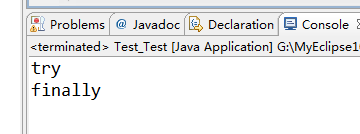
- 情况4:try{ return; }catch(){} finally{return;}
程序执行try块中return之前(包括return语句中的表达式运算)代码;
再执行finally块,因为finally块中有return所以提前退出。
1 package Test; 2 3 public class Test_Test { 4 public static void main(String[] args) { 5 Test1(); 6 } 7 8 public static int Test1(){ 9 int x = 5; 10 try 11 { 12 int num = x / 0; 13 System.out.println("try"); 14 return 3; 15 } 16 catch (ArithmeticException e) { 17 System.err.println("除数不能为0!"); 18 } 19 finally 20 { 21 ++x; 22 System.out.println("finally"); 23 return 2; 24 } 25 } 26 }
运行结果如下:
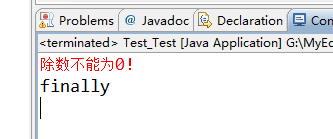
- 情况5:try{} catch(){return;}finally{return;}
程序执行catch块中return之前(包括return语句中的表达式运算)代码;
再执行finally块,因为finally块中有return所以提前退出。
1 package Test; 2 3 public class Test_Test { 4 public static void main(String[] args) { 5 Test1(); 6 } 7 8 public static int Test1(){ 9 int x = 5; 10 try 11 { 12 int num = x / 0; 13 System.out.println("try"); 14 } 15 catch (ArithmeticException e) { 16 System.err.println("除数不能为0!"); 17 return 4; 18 } 19 finally 20 { 21 ++x; 22 System.out.println("finally"); 23 return 2; 24 } 25 } 26 }
运行结果如下:
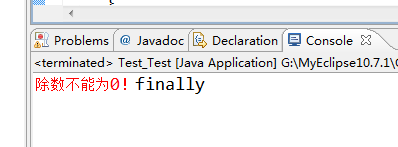
- 情况6:try{ return;}catch(){return;} finally{return;}
程序执行try块中return之前(包括return语句中的表达式运算)代码;
有异常:执行catch块中return之前(包括return语句中的表达式运算)代码;
则再执行finally块,因为finally块中有return所以提前退出。
无异常:则再执行finally块,因为finally块中有return所以提前退出。
1.有异常
1 package Test; 2 3 public class Test_Test { 4 public static void main(String[] args) { 5 Test1(); 6 } 7 8 public static int Test1(){ 9 int x = 5; 10 try 11 { 12 int num = x / 0; 13 System.out.println("try"); 14 return 4; 15 } 16 catch (ArithmeticException e) { 17 System.err.println("除数不能为0!"); 18 return 4; 19 } 20 finally 21 { 22 ++x; 23 System.out.println("finally"); 24 return 2; 25 } 26 } 27 }
运行结果如下:

2.无异常
1 package Test; 2 3 public class Test_Test { 4 public static void main(String[] args) { 5 Test1(); 6 } 7 8 public static int Test1(){ 9 int x = 5; 10 try 11 { 12 // int num = x / 0; 13 // System.out.println("try"); 14 return 4; 15 } 16 catch (ArithmeticException e) { 17 System.err.println("除数不能为0!"); 18 return 4; 19 } 20 finally 21 { 22 ++x; 23 System.out.println("finally"); 24 return 2; 25 } 26 } 27 }
运行结果如下:
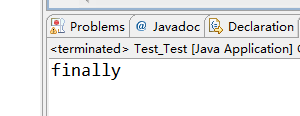
最终结论:任何执行try 或者catch中的return语句之前,都会先执行finally语句,如果finally存在的话。
如果finally中有return语句,那么程序就return了,所以finally中的return是一定会被return的,
编译器把finally中的return实现为一个warning。
- throw——抛出异常
抛出异常有三种形式,一是throw,一个throws,还有一种系统自动抛异常。
系统抛出异常:
1 package Test; 2 3 public class Test2 { 4 public static void main(String[] args) { 5 int a = 5, b =0; 6 System.out.println(5/b); 7 } 8 9 }
运行结果如下:

throw抛出异常:
throw是语句抛出一个异常。
语法:throw (异常对象);
1 package Test; 2 3 public class Test2 { 4 public static void main(String[] args) { 5 String s = "abc"; 6 if(s.equals("abc")) { 7 throw new NumberFormatException(); 8 } else { 9 System.out.println(s); 10 } 11 } 12 13 }
运行结果如下:

- throws——声明异常
throws是方法可能抛出异常的声明。(用在声明方法时,表示该方法可能要抛出异常)
语法:[(修饰符)](返回值类型)(方法名)([参数列表])[throws(异常类)]{......}
1 package Test; 2 3 public class Test2 { 4 public static void main(String[] args) { 5 try { 6 Test3(); 7 } catch (NumberFormatException e) { 8 System.err.println("非数据类型不能转换。"); 9 } 10 } 11 12 public static void Test3() throws NumberFormatException{ 13 String s = "abc"; 14 System.out.println(Double.parseDouble(s)); 15 } 16 }
运行结果如下:

如果在一个方法体中抛出了异常,那么我们就可以通过throws——声明异常来通知调用者,非常方便。
throws表示出现异常的一种可能性,并不一定会发生这些异常;throw则是抛出了异常,执行throw则一定抛出了某种异常对象。
最后说一句,try-catch-finally虽好用,但是如果是滥用,这样只是会让程序的可读性变的很糟糕,当程序报错,就无法快速准确的定位了,物尽其用 人尽其才嘛!